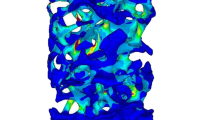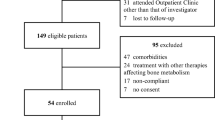Abstract
Summary
Bone modulus from patients with osteoporosis treated with bisphosphonates for 1 to 20 years was analyzed. Modulus increases during the first 6 years of treatment and remains unchanged thereafter.
Introduction
Bisphosphonates are widely used for treating osteoporosis, but the relationship between treatment duration and bone quality is unclear. Since material properties partially determine bone quality, the present study quantified the relationship between human bone modulus and hardness with bisphosphonate treatment duration.
Methods
Iliac crest bone samples from a consecutive case series of 86 osteoporotic Caucasian women continuously treated with oral bisphosphonates for 1.1–20 years were histologically evaluated to assess bone turnover and then tested using nanoindentation. Young’s modulus and hardness were measured and related to bisphosphonate treatment duration by statistical modeling.
Results
All bone samples had low bone turnover. Statistical models showed that with increasing bisphosphonate treatment duration, modulus and hardness increased, peaked, and plateaued. These models used quadratic terms to model modulus increases from 1 to 6 years of bisphosphonate treatment and linear terms to model modulus plateaus from 6 to 20 years of treatment. The treatment duration at which the quadratic–linear transition (join point) occurred also depended upon trabecular location. Hardness increased and peaked at 12.4 years of treatment; it remained constant for the next 7.6 years of treatment and was insensitive to trabecular location.
Conclusions
Bone modulus increases with bisphosphonate treatment durations up to 6 years, no additional modulus increases occurred after 6 years of treatment. Although hardness increased, peaked at 12.4 years and remained constant for the next 7.6 years of BP treatment, the clinical relevance of hardness remains unclear.




Similar content being viewed by others
References
Pazianas M, van der Geest S, Miller P (2014) Bisphosphonates and bone quality. Bonekey Rep 3:529
Schmidt GA, Horner KE, McDanel DL, Ross MB, Moores KG (2010) Risks and benefits of long-term bisphosphonate therapy. Am J Health Syst Pharm 67:994–1001
Adler RA, El-Hajj Fuleihan G, Bauer DC et al (2016) Managing osteoporosis in patients on long-term bisphosphonate treatment: report of a task force of the American Society for Bone and Mineral Research. J Bone Miner Res 31:16–35
Wright NC, Looker AC, Saag KG, Curtis JR, Delzell ES, Randall S, Dawson-Hughes B (2014) The recent prevalence of osteoporosis and low bone mass in the United States based on bone mineral density at the femoral neck or lumbar spine. J Bone Miner Res 29:2520–2526
(2016) The duration and safety of osteoporosis treatment. Abrahamsen B and Stuart Silverman S (eds). Springer International Publishing, pp. 17-36
Hollick RJ, Reid DM (2011) Role of bisphosphonates in the management of postmenopausal osteoporosis: an update on recent safety anxieties. Menopause Int 17:66–72
Cummings SR, Black DM, Thompson DE, Applegate WB, Barrett-Connor E, Musliner TA, Palermo L, Prineas R, Rubin SM, Scott JC, Vogt T, Wallace R, Yates AJ, LaCroix A (1998) Effect of alendronate on risk of fracture in women with low bone density but without vertebral fractures: results from the Fracture Intervention Trial. JAMA 280:2077–2082
Miller PD (2016) Underdiagnosis and undertreatment of osteoporosis: the battle to be won. J Clin Endocrinol Metab 101:852–859
Burr DB, Lane JE, Howe TS, Ng AC, Ebeling PR (2017) Response to PD Miller, Underdiagnosis and undertreatment of osteoporosis: the battle to be won. J Clin Endocrinol Metab 102:1088–1089
Boskey AL, Spevak L, Weinstein RS (2009) Spectroscopic markers of bone quality in alendronate-treated postmenopausal women. Osteoporos Int 20:793–800
Bala Y, Farlay D, Chapurlat RD, Boivin G (2011) Modifications of bone material properties in postmenopausal osteoporotic women long-term treated with alendronate. Eur J Endocrinol 165:647–655
Gourion-Arsiquaud S, Allen MR, Burr DB, Vashishth D, Tang SY, Boskey AL (2010) Bisphosphonate treatment modifies canine bone mineral and matrix properties and their heterogeneity. Bone 46:666–672
Tang SY, Allen MR, Phipps R, Burr DB, Vashishth D (2009) Changes in non-enzymatic glycation and its association with altered mechanical properties following 1-year treatment with risedronate or alendronate. Osteoporos Int 20:887–894
Day JS, Ding M, Bednarz P, van der Linden JC, Mashiba T, Hirano T, Johnston CC, Burr DB, Hvid I, Sumner DR, Weinans H (2004) Bisphosphonate treatment affects trabecular bone apparent modulus through micro-architecture rather than matrix properties. J Orthop Res 22:465–471
Ward J, Wood CL, Pienkowski D, Malluche HH (2016) Stiffness and strength of bone in osteoporotic patients treated with varying durations of oral bisphosphonates. Osteoporos Int 27:2681–2688
Mashiba T, Hirano T, Turner CH, Forwood MR, Johnston CC, Burr DB (2000) Suppressed bone turnover by bisphosphonates increases microdamage accumulation and reduces some biomechanical properties in dog rib. J Bone Miner Res 15:613–620
Bala Y, Depalle B, Farlay D, Douillard T, Meille S, Follet H, Chapurlat R, Chevalier J, Boivin G (2012) Bone micromechanical properties are compromised during long-term alendronate therapy independently of mineralization. J Bone Miner Res 27:825–834
Mosekilde L, Viidik A, Mosekilde L (1985) Correlation between the compressive strength of iliac and vertebral trabecular bone in normal individuals. Bone 6:291–295
Britton JM, Davie MW (1990) Mechanical properties of bone from iliac crest and relationship to L5 vertebral bone. Bone 11:21–28
Monier-Faugere MC, Langub MC, Malluche HH (1997) Bone biopsies: a modern approach. In: Avioli LV, Krane SM (eds) Metabolic bone disease, 3rd edn. WB Saunders Co, pp 237–273
Malluche HHMH, Monier-Faugere MC (2008) Bone biopsy in patients with osteoporosis. Curr Osteoporosis Rep 5:146–152
Malluche HH and Monier-Faugere MC (1986) Atlas of mineralized bone histology. Karger, Basel, pp. 18–25.
Rho JY, Tsui TY, Pharr GM (1997) Elastic properties of human cortical and trabecular lamellar bone measured by nanoindentation. Biomaterials 18:1325–1330
Malluche HH, Porter DS, Monier-Faugere MC, Mawad H, Pienkowski D (2012) Differences in bone quality in low- and high-turnover renal osteodystrophy. J Am Soc Nephrol 23:525–532
Oliver WC, Pharr GM (2004) Measurement of hardness and elastic modulus by instrumented indentation: advances in understanding and refinements to methodology. J Mater Res 19:3–20
Oliver WC, Pharr GM (1992) An improved technique for determining hardness and elastic modulus using load and displacement sensing indentation experiment. J Mater Res 7:1564–1583
Donnelly E, Meredith DS, Nguyen JT, Boskey AL (2012) Bone tissue composition varies across anatomic sites in the proximal femur and the iliac crest. J Orthop Res 30:700–706
Fan Z, Rho JY (2003) Effects of viscoelasticity and time-dependent plasticity on nanoindentation measurements of human cortical bone. J Biomed Mater Res A 67:208–214
Zoehrer R, Roschger P, Paschalis EP, Hofstaetter JG, Durchschlag E, Fratzl P, Phipps R, Klaushofer K (2006) Effects of 3- and 5-year treatment with risedronate on bone mineralization density distribution in triple biopsies of the iliac crest in postmenopausal women. J Bone Miner Res 21:1106–1112
Roschger P, Rinnerthaler S, Yates J, Rodan GA, Fratzl P, Klaushofer K (2001) Alendronate increases degree and uniformity of mineralization in cancellous bone and decreases the porosity in cortical bone of osteoporotic women. Bone 29:185–191
Tjhia CK, Stover SM, Rao DS, Odvina CV, Fyhrie DP (2012) Relating micromechanical properties and mineral densities in severely suppressed bone turnover patients, osteoporotic patients, and normal subjects. Bone 51:114–122
Maruyama N, Shibata Y, Wurihan, Swain MV, Kataoka Y, Takiguchi Y, Yamada A, Maki K, Miyazaki T (2014) Strain-rate stiffening of cortical bone: observations and implications from nanoindentation experiments. Nanoscale 6:14863–14871
Black DM, Thompson DE, Bauer DC, Ensrud K, Musliner T, Hochberg MC, Nevitt MC, Suryawanshi S, Cummings SR, Fracture Intervention T (2000) Fracture risk reduction with alendronate in women with osteoporosis: the Fracture Intervention Trial. FIT Research Group. J Clin Endocrinol Metab 85:4118–4124
Chavassieux PM, Arlot ME, Reda C, Wei L, Yates AJ, Meunier PJ (1997) Histomorphometric assessment of the long-term effects of alendronate on bone quality and remodeling in patients with osteoporosis. J Clin Invest 100:1475–1480
Hoffler CE, Moore KE, Kozloff K, Zysset PK, Goldstein SA (2000) Age, gender, and bone lamellae elastic moduli. J Orthop Res 18:432–437
Ding M, Dalstra M, Danielsen CC, Kabel J, Hvid I, Linde F (1997) Age variations in the properties of human tibial trabecular bone. J Bone Joint Surg (Br) 79:995–1002
Wang X, Allen MR, Burr DB, Lavernia EJ, Jeremic B, Fyhrie DP (2008) Identification of material parameters based on Mohr-Coulomb failure criterion for bisphosphonate treated canine vertebral cancellous bone. Bone 43:775–780
Zysset PK, Guo XE, Hoffler CE, Moore KE, Goldstein SA (1999) Elastic modulus and hardness of cortical and trabecular bone lamellae measured by nanoindentation in the human femur. J Biomech 32:1005–1012
Mittra E, Akella S, Qin YX (2006) The effects of embedding material, loading rate and magnitude, and penetration depth in nanoindentation of trabecular bone. J Biomed Mater Res A 79:86–93
Bushby AJ, Ferguson VL, Boyde A (2004) Nanoindentation of bone: comparison of specimens tested in liquid and embedded in polymethylmethacrylate. J Mater Res 19:249–259
Rho JY, Pharr GM (1999) Effects of drying on the mechanical properties of bovine femur measured by nanoindentation. J Mater Sci Mater Med 10:485–488
Li ZC, Dai LY, Jiang LS, Qiu S (2012) Difference in subchondral cancellous bone between postmenopausal women with hip osteoarthritis and osteoporotic fracture: implication for fatigue microdamage, bone microarchitecture, and biomechanical properties. Arthritis Rheum 64:3955–3962
Brody JE (2018) A perfect storm for broken bones. The New York Times, New York
Acknowledgments
Financial support from the National Institute of Arthritis and Musculoskeletal and Skin Diseases of the National Institutes of Health (R01 AR061578) and the Kentucky Nephrology Research Trust is gratefully acknowledged. Daniel Shaw Porter, PhD provided technical assistance and George Pharr, PhD and the High Temperature Materials Group at Oak Ridge National Laboratory provided advice. Jin Xie provided assistance with statistical analyses. Opinions expressed herein are those of the authors and do not necessarily represent the official views of the National Institutes of Health.
Funding
All authors were supported by NIH-NIAMS Award R01 AR061578. HM was also supported by the Kentucky Nephrology Research Trust.
Author information
Authors and Affiliations
Corresponding author
Ethics declarations
Conflicts of interest
David Pienkowski, Constance Wood, and Hartmut Malluche declare that they have no conflict of interest. This study was supported by awards from the National Institute of Arthritis and Musculoskeletal and Skin Diseases of the National Institutes of Health (R01 AR061578) and the Kentucky Nephrology Research Trust.
Rights and permissions
About this article
Cite this article
Pienkowski, D., Wood, C.L. & Malluche, H.H. Young’s modulus and hardness of human trabecular bone with bisphosphonate treatment durations up to 20 years. Osteoporos Int 30, 277–285 (2019). https://doi.org/10.1007/s00198-018-4760-x
Received:
Accepted:
Published:
Issue Date:
DOI: https://doi.org/10.1007/s00198-018-4760-x




